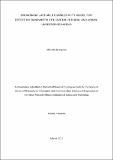| dc.description.abstract | Broadband last-mile connectivity is a necessary access infrastructure to bridge the digital divide which is more pronounced in rural areas and is also a means to drive the utilization of international bandwidth that is available to a country. Rural areas inhabit more than 70% of the population in Tanzania and are characterized with poor basic infrastructure and services such as roads, schools, hospitals, financial and social services. Engagement of rural communities is crucial for economic development. In the beginning of the 20th century and beyond, the major problem was to find a technology that would successfully connect the rural and remote areas cost effectively. At that time the only feasible technology for these areas were satellite and wired technologies, which required huge investment funding to connect the users; especially those in areas that have sparsely distributed population and far away from urban centres. The main objective of this research is to develop a broadband last-mile connectivity model for efficient bandwidth utilization. The study builds on the telecentre model that have since the beginning of the 20th century been introduced to serve the scattered users in the remote, rural and or underserved areas which seemed un attractive for investment. This research reviews the general status of telecommunication services provision in rural areas using Arusha, Tanzania as a case study and proposes the optimized bandwidth Rural Broadband Service Broker (RBSB) model to solve the problem of low utilization of broadband services in rural and urban-underserved areas. The proposed model not only ensures efficient utilization of resource but is also a way to aggregate users at a common centre where knowledge transfer is achieved. The study has employed qualitative and qualitative research methods for the state of art part of the study and scientific design, modelling simulation to develop the optimized bandwidth RBSB model using MATLAB software. The findings show that with proper optimization solution, it is possible to provide services in low income areas to achieve both quality and affordable price through resource sharing and utilizing the unused chunks of bandwidth using Cognitive Networks Analysis. The proposed model eliminates the high dependence on government and donor funding to reach rural areas and hence promise affordable and sustainable service provision. The recommended model requires among others the entities such as the UCSAF to consider this model as a tool to speed up the universal communication access process and hence provide initial/start-up funding, training, technical advice and Monitoring and Evaluation to those who are willing to venture into this business. This is expected to ensure the universal communication access to broadband services in rural and urban-underserved areas is achieved. | en_US |

